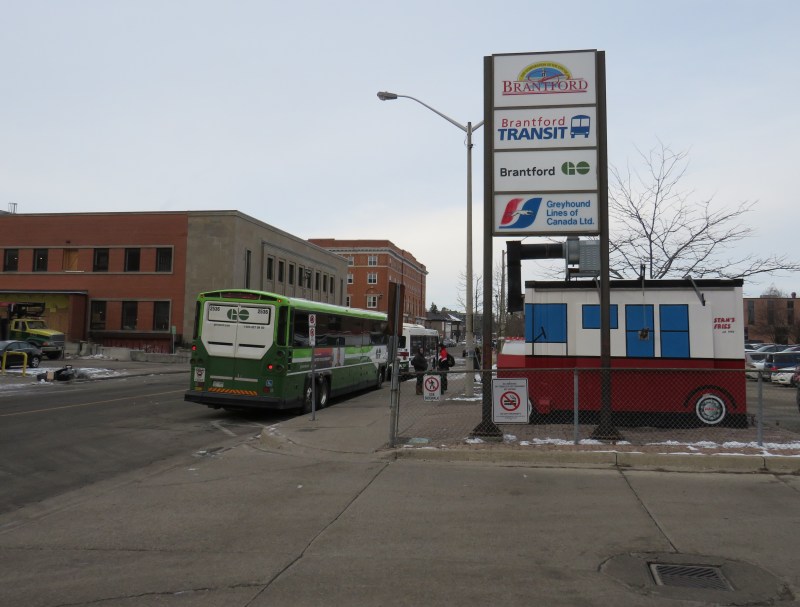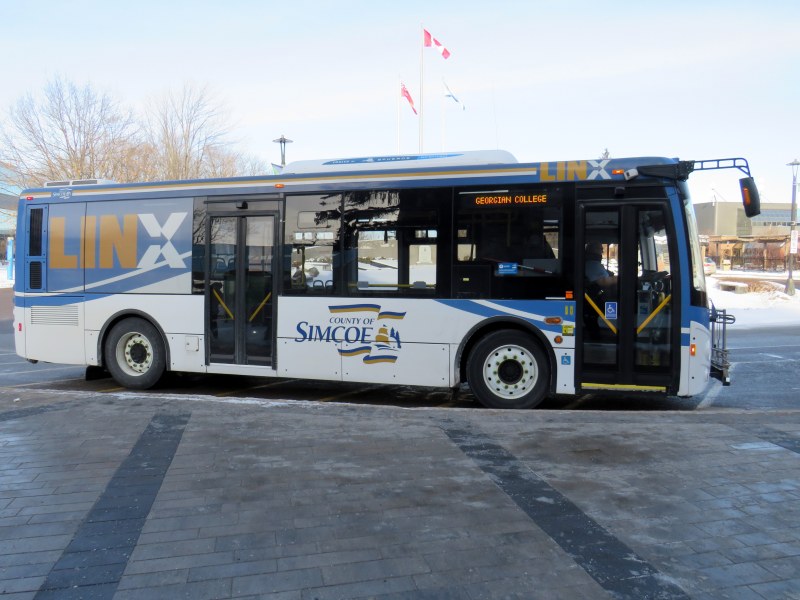
RideNorfolk buses at Norfolk County Hall, Simcoe
Over the last three years, I wrote about the gaps in intercity rail and coach services in Ontario, and how some companies were working to fill them.
In Northern Ontario, Ontario Northland and Kasper Transportation worked to fill the void left by Greyhound’s departure from Western Canada, with both companies offering new links to towns such as Hearst and Fort Francis.
Unfortunately, there have also been some setbacks. Wroute, a shared taxi service in the Kitchener-Guelph-Hamilton triangle, was operational for less than a year. Though GO Transit added new weekday trains between Guelph and Kitchener, none allow for Kitchener-bound commutes, and there has not been interest in serving those gaps identified by Wroute.
Outside of Northern Ontario and the Golden Horseshoe, many cities and towns remain disconnected from nearby communities and larger centres. Though every city and town in Ontario had daily bus and/or rail service in the 1980s, many communities are now completely inaccessible for anyone without access to a car. Though GO Transit expanded to Peterborough, Brantford, Niagara, and Kitchener in the last fifteen years, they are extensions of GO’s radial network from Toronto rather than a true intercity network.
St. Thomas, population 41,000, is the largest city in the province without any passenger links, despite being a short drive to London. Many other cities and towns — particularly in Midwestern and Eastern Ontario — find themselves in similar situations. A few other cities, such as Sarnia (which has just one train a day each way to London and Toronto), are grossly under-served.
But thanks to municipal innovation and a new provincial grant program, this is finally changing. Though several municipalities addressed this problem early on, three new inter-municipal bus systems began operations in 2019, with many more launching this year.
Early adopters
From 2000 to 2015, new inter-city and rural transportation links were launched by regional governments and amalgamated cities, such as Waterloo, Durham, and Niagara Regions, and the municipality of Chatham-Kent. These municipalities provide these services for the benefit of their residents and businesses and are subsidized as any urban transit system is.
Grand River Transit, in Waterloo Region, began as an amalgamation of municipal bus services in Kitchener and Cambridge which were not connected before 2001. Since then, GRT introduced new rural routes to St. Jacobs and Elmira in Woolwich Township, and to Baden and New Hamburg in Wilmot Township. Route 21 Elmira now runs six days a week and connects to the new ION LRT at Conestoga Mall. In Durham Region, the outlying towns of Uxbridge and Port Perry now have direct bus connections to Durham College in Oshawa and Newmarket.
Though seven separate municipal transit systems operate in Niagara Region, Niagara Region Transit was established by the regional government to connect those systems, rather than take them over completely. Hourly bus services operate between St. Catharines, Niagara Falls, and Welland, with additional routes to Port Colborne and Fort Erie. Though the cash fare is $6, free transfers may be made to/and from most local transit services.
The municipality of Chatham-Kent in Southwestern Ontario was formed through the amalgamation of the City of Chatham with 21 surrounding towns, villages, and townships. Though Chatham had its own local transit system, the new municipality launched three rural routes starting in 2007. These routes connect Chatham to Wallaceburg, Dresden, Ridgetown, Tilbury, and Blenheim, and operate six days a week. Midday runs were added in September 2019.
An interesting exception to this early phase is Deseronto, a town of fewer than 2,000 residents on the Bay of Quinte. That small municipality has operated a transit service between Napanee, Deseronto, and the City of Belleville since 2007. Initially established to provide connections to nearby employment centres, buses also serve shopping destinations, Belleville General Hospital, and Loyalist College. In 2014, a second route was added between Belleville, Bloomfield and Picton.
New connections and provincial support
Simcoe County Linx, developed by the county government, first started in 2018, with a route operating between Barrie, Midland, and Penetanguishine. This filled a crucial gap left by the demise of Penetang-Midland Coach Lines. In 2019, additional routes were added between Barrie, Wasaga Beach, and Collingwood (which previously had just one daily Greyhound trip), and between Barrie and Orillia. Routes radiating from Barrie operate approximately every hour during weekday mornings and afternoons, with daily Wasaga Beach-Collingwood service. The final two routes, between Midland and Orillia, and between Bradford and Alliston will start later this year.

2016 map depicting proposed new bus connections in Simcoe County. Route 2, launched in 2019, was altered to serve Angus, replacing Barrie Transit Route 90 (“C”).
In January 2019, the provincial government announced the expansion of the Community Transportation Grant Program, offering $30 million over five years to 39 municipalities. The five year funding period provides municipalities time to plan new routes, contract operations, launch the new service, and build ridership.
Norfolk County, on Lake Erie southwest of Hamilton, was one of the first municipalities to take advantage of the new program. Its contracted transit service, RideNorfolk, had already operated a local bus service within the town of Simcoe along with weekly shuttles to outlying towns and villages within the county. With grant funding, RideNorfolk began weekday bus service between Simcoe, Waterford, and Brantford in May 2019, offering three round trips.
Simcoe was one of many towns left without intercity transportation with the discontinuance of Greyhound’s Highway 3 service between London and Niagara Falls over a decade ago. Fares for the new bus are $10 each way, far cheaper than a taxi ride. At Downtown Brantford, passengers can walk to Wilfrid Laurier University’s Brantford campus or make connections to local Brantford Transit buses, GO Transit buses to McMaster University and Aldershot Station, and Greyhound buses to Toronto and London.

Connections at Brantford Bus Terminal include local buses, GO Transit, Greyhound, and RideNorfolk
With the new provincial funding, the Town of Leamington launched Route 42 in July 2019, restoring daily bus service along Highway 3 in Essex County. Service is offered six days a week between Leamington and St. Clair College in Windsor, with stops in Kingsville and Essex. At St. Clair College, free transfers can be made to Transit Windsor. Unfortunately, the bus stops are located at recreation complexes on the outskirts of Leamington, Essex, and Kingsville, rather than closer to the town centres, limiting the walking distance catchment areas for each stop. Fares are $10 one-way, $15 same-day return, with discounted passes and multi-ride tickets.
 LTW Transit Route 42 between Leamington and Windsor (from Town of Leamington website)
LTW Transit Route 42 between Leamington and Windsor (from Town of Leamington website)
More inter-municipal services are set to launch in 2020. These include:
- A route between London and Sarnia, with stops in Lambton and Middlesex Counties, including Strathroy, Komoka, and Mount Brydges. This service will be operated by London-based Voyago beginning April 1, 2020, funded by grants to Middlesex County and Stratrhoy-Caradoc. Service to the nearby town of Lambton Shores (communities of Forest, Grand Bend) may follow. Sarnia mayor Mike Bradley welcomes the new service, but warns that too many stops will “…dilute what the point of this was.”
- Oxford County will introduce a new weekday route connecting Woodstock, Ingersoll, and Tillsonburg, with supplemental services to London, Port Burwell, and Delhi, connecting with RideNorfolk. That route will also launch April 1, and will be operated by Voyago.

Planned Tillsonburg/Oxford County routes (from T:GO Transit webpage) - Within Perth County, new routes are planned connecting Stratford to Kitchener, St. Marys, and London, between Stratford and Listowel, and between Listowel and Kitchener. Though VIA Rail operates two daily trains between Kitchener and London, VIA’s schedules are not convenient for commuters or students to either city from Stratford or St. Marys.
- Grey County is planning new routes on Highway 10 between Owen Sound, Dundalk, Shelburne and Orangeville, and on Highway 26 to Meaford and Town of Blue Mountains (connecting with Collingwood Transit and Simcoe County) with a secondary route to Wiarton.
- Owen Sound entered a separate contract with Voyago for a new Highway 6 service to Guelph, with intermediate stops in towns including Durham, Mount Forest, and Fergus, with service to start in April. Interestingly, Kasper Transportation, which also bid for the route, began operating on the corridor on January 15.
- Selwyn Township and Curve Lake First Nation https://www.thepeterboroughexaminer.com/news-story/9705146-city-buses-will-start-running-from-peterborough-to-lakefield-curve-lake-ennismore-bridgenorth/
 T:GO minibus in front of one of Tillsonburg ‘s historic railway stations. Currently, T:GO
T:GO minibus in front of one of Tillsonburg ‘s historic railway stations. Currently, T:GO
Not yet a network
As municipal governments were required to submit grant applications to the Ministry of Transportation for provincial funding, with funds dispersed at the discretion of the ministry, many communities that require bus links will continue to do without.
In addition, many of these individual bus and van routes do not connect well with other services. One of Ride Norfolk’s strengths is its downtown terminal connection to local Brantford Transit buses and GO Transit’s bus route to McMaster University and Aldershot rail station. The new Oxford County system launching in April will connect Tillsonburg and Ingersoll to Woodstock’s hospital, Woodstock Transit, and VIA Rail for connections to London and Toronto.
But Simcoe County Lynx has two terminals in Barrie: buses to Midland/Penetanguishine and Orillia terminate at Georgian College, while buses to Angus and Wasaga Beach terminate at the Allandale Waterfront GO Station. Local Barrie Transit buses must be used to get between the two terminals, and there is no fare integration between Barrie and Simcoe County buses. Ideally, all routes would terminate at a central transit hub, with logical schedule and fare coordination between all agencies, including GO Transit.
 Simcoe County Linx bus at Georgian College in Barrie. Though stops at the college and nearby Royal Victoria College are helpful for many, the lack of a direct connection to GO Transit or fare integration are drawbacks of the new service.
Simcoe County Linx bus at Georgian College in Barrie. Though stops at the college and nearby Royal Victoria College are helpful for many, the lack of a direct connection to GO Transit or fare integration are drawbacks of the new service.
There remain some notable absences from the list of funded grant applications, particularly between neighbouring towns and cities, such as St. Thomas-London, and Quinte West-Belleville. Other communities in western and central Ontario, including Hagersville and Caledonia in Haldimand County, both within commuting distance from Hamilton, remain disconnected.
A robust, frequent, and reliable rail and bus network, with local connections to smaller communities, is essential for getting workers to jobs, students to school, patients to health services, and seniors to social gatherings. As the province looks to address some of these challenges in the new draft transportation plan for southwestern Ontario, it would be wise to fully develop a transportation network, building on some of this recent progress. Better awareness of these services, including adding them Google Transit and a public awareness strategy will help as well.
Otherwise, we will just have a patchwork of buses with missed connections.

One reply on “A patchwork of new intercity connections in Ontario”
Great research Sean.